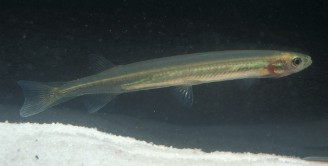Native freshwater fishes of
Western Australia
The distribution of freshwater fish throughout Western Australia is based on our surveys of >2000 individual sites. But just knowing where things are is only part of being able to conserve these fauna: understanding the biology and ecology of those species and their ecosystems is also vitally important.
Balston's Pygmy Perch
Photo: D. Morgan
FISH FACT: Did you know that the elusive Balston's Pygmy Perch (Nannatherina balstoni) (above) was first described from the King River near Albany - it was known as the King River Perchlet. It is now thought to be lost from that system. It is one of our rare fishes in need of a bit of help and as a result in 2006 we nominated the species under the EPBC Act and Wildlife Conservation Act as being Vulnerable. A species that from about 25 mm total length eats almost exclusively from the water surface, a diet mostly of spiders, ants and other insects such as midges and mozzies.
Further reading:
Beatty, S.J., Morgan, D.L., Rashnavadi, M. & Lymbery, A.J. (2011). Salinity tolerances of endemic freshwater fishes of south-western Australia: implications for conservation in a biodiversity hotspot. Marine & Freshwater Research 62: 91-100.
Gill, H.S. & Morgan, D.L. (1998). Larval development of Nannatherina balstoni Regan (Nannopercidae), with a description of ontogenetic changes in diet. Ecology of Freshwater Fish 7: 132-139.
Morgan, D.L., Gill, H.S. & Potter, I.C. (1995). Life cycle, growth and diet of Balston's pygmy perch in its natural habitat of acidic pools. Journal of Fish Biology 47: 808-825.
Morgan, D.L. (2009). Threatened fishes of the world: Nannatherina balstoni Regan 1906 (Nannopercidae). Environmental Biology of Fishes 84: 409-410.
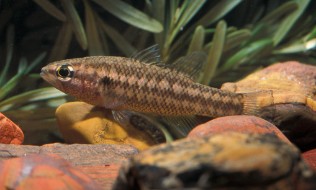
Western Pygmy Perch
Photo: S. Beatty
FISH FACT: The Western Pygmy Perch (Nannoperca vittata) is one of the south-west's most widely distributed fishes. It is ocassionally very abundant but has declined due to salinisation and is impacted on by feral fishes such as Redfin Perch and Eastern Mosquitofish. It is a lot slower growing than the Balston's Pygmy Perch and its diet differs in that it eats mostly from within the water column. An attractive and easy to look after aquarium fish and great for outdoor ponds.
Further reading:
Beatty, S.J., Morgan, D.L., Rashnavadi, M. & Lymbery, A.J. (2011). Salinity tolerances of endemic freshwater fishes of south-western Australia: implications for conservation in a biodiversity hotspot. Marine & Freshwater Research 62: 91-100.
Morgan, D.L., Gill, H.S. & Potter, I.C. (1998). Distribution, identification and biology of freshwater fishes in south-western Australia. Records of the Western Australian Museum Supplement No. 56: 97 pp.
Pen, L.J. & Potter, I.C. (1995). Biology of the western pygmy perch, Edelia vittata and comparisons with two other teleost species endemic to south-western Australia. Environmental Biology of Fishes 31: 365-380.
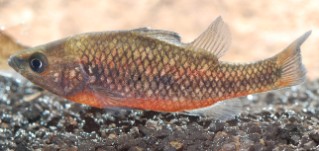
Freshwater Cobbler
Photo: M. Allen
FISH FACT: South-western Australia's largest freshwater fish, the Freshwater Cobbler (Tandanus bostocki) grows to almost 50 cm in total length, and is most common in out larger river systems, but has declined in some. The species breeds in late spring and early summer and undertakes upstream migrations in large numbers during this time. Maturtiy is reached by about 20 cm in length. The diet consists of crustaceans (such as shrimp and gilgies), fish (Western Pygmy Perch) and molluscs (mussels). It is also a known host to the parasitic larval stage of Carter's Freshwater Mussel.
Further reading:
Beatty, S.J., Morgan, D.L., McAleer, F.J. & Ramsay, A.R. (2010). Groundwater contribution to baseflow maintains habitat connectivity for Tandanus bostocki (Teleostei: Plotosidae) in a south-western Australian river. Ecology of Freshwater Fish 19: 595-608.
Klunzinger, M.W., Beatty, S.J., Morgan, D.L., Lymbery, R., Thomson, G.J. & Lymbery, A.J. (2011). Discovery of a host fish species for glochidia of Westralunio carteri Iredale, 1934 (Bivalvia: Unionoida: Hyriidae). Journal of the Royal Society of Western Australia 94: 19-23.
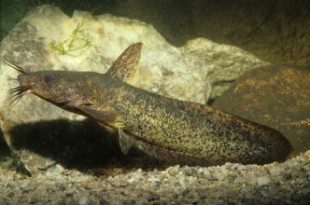
Nightfish
Photo: S. Beatty
FISH FACT: The Nightfish (Bostockia porosa) is one of the south-west's most widely distributed fishes. It is ocassionally very abundant but has declined due to salinisation and is impacted on by feral fishes such as Redfin Perch and Eastern Mosquitofish. It is one of the largest freshwater fish in the region and is an ambush predator.
Further reading:
Morgan, D.L., Gill, H.S. & Potter, I.C. (1998). Distribution, identification and biology of freshwater fishes in south-western Australia. Records of the Western Australian Museum Supplement No. 56: 97 pp.

Western Minnow
Photo: D. Morgan
FISH FACT: The Western Minnow (Galaxias occidentalis) is one of the south-west's most widely distributed fishes. It is also one of the most abundant species and grows to almost 20 cm, but is more commonly less than 15cm in total length.
Further reading:
Beatty, S.J., Morgan, D.L., Rashnavadi, M. & Lymbery, A.J. (2011). Salinity tolerances of endemic freshwater fishes of south-western Australia: implications for conservation in a biodiversity hotspot. Marine & Freshwater Research 62: 91-100.
Morgan, D.L., Gill, H.S. & Potter, I.C. (1998). Distribution, identification and biology of freshwater fishes in south-western Australia. Records of the Western Australian Museum Supplement No. 56: 97 pp.
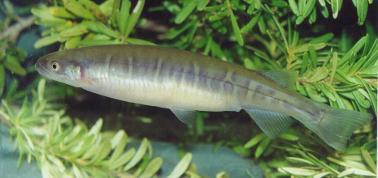
OUR SURVEY SITE DATABASE

Salamanderfish
Photo: G. Allen
FISH FACT: A Gondwanan relic, the salamanderfish (Lepidogalaxias salamandroides) or sally is in its own family and has many characters and characteristics that make it one of the world's most unique fishes. Aestivation (burying in the mud), bendable neck, unique sperm, mucous secretion, cutaneous aeration, unique anal fin in males and eyes that don't move - what more do we want. We've got a gem living under our noses.
Further reading:
Morgan, D.L., Gill, H.S. & Potter, I.C. (2000). Age composition, growth and reproductive biology of the salamanderfish Lepidogalaxias salamandroides: a re-examination. Environmental Biology of Fishes 57: 191-204.
Gill, H.S. & Morgan, D.L. (1999). Larval development in the salamanderfish, Lepidogalaxias salamandroides. Copeia 1999: 219-224.
Black-stripe Minnow
Photo: G. Allen
FISH FACT: Ye old Black-stripe Minnow (Galaxiella nigrostriata) is our smallest freshwater fish but is extremely unusual. Often found with the sally (above) in ephemeral wetalnds, it has suffered massive reductions in range due to loss of habitats, particularly on the Swan Coatal Plain. The main populations are between Augusta and Walpole but there are outlying populations in Ellen Brook and near Bunbury, although these populations won't be around forever, particularly with the way the joint is drying out. As an aestivating species (we think), groundwater is critical to their survival, that means soil needs to be moist to keep 'em alive. I hope they hang around for our kids as they are one of our prettiest fish and are ecologically important in that they eat loads of midges and mozzies.
Further reading:
Gill, H.S. & Morgan, D.L. (1996). Threatened fishes of the world: Galaxiella nigrostriata (Shipway, 1953) (Galaxiidae). Environmental Biology of Fishes 47: 344.
Gill, H.S. & Morgan, D.L. (2003). Ontogenetic changes in the diet of Galaxiella nigrostriata (Shipway, 1953) (Galaxiidae) and Lepidogalaxias salamandroides Mees, 1961 (Lepidogalaxiidae). Ecology of Freshwater Fish 12: 151-158.
Morgan, D.L., Gill, H.S. & Potter, I.C. (1998). Distribution, identification and biology of freshwater fishes in south-western Australia. Records of the Western Australian Museum Supplement No. 56: 97 pp.
Pen, L.J., Gill, H.S., Potter, I.C. & Humphries, P. (1993). Growth, age composition, reproductive biology and diet of the black-stripe minnow Galaxiella nigrostriata (Shipway), including comparisons with the other two Galaxiella species. Journal of Fish Biology 43: 847-864.
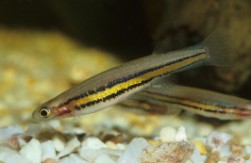
Western Mud Minnow
Photo: D. Morgan
FISH FACT: The muddy, or Western Mud Minnow (Galaxiella munda) is the closest rellie to the Black-strip Minnow, but instead of being found in ephemeral waterbodies, it is found in spring-fed headwater streams that are the result of groundwater expression. Take the Yaragadee as an example, these species is most secure in Yaragadee Aquifer-fed streams. At least we aren't drawing that aquifer down - PHEW. The species has a one year life-cycle so if something negative happens in their streams then they are likely to go kaput. Big worry considering our recent year of climate change.
Further reading:
Gill, H.S. & Morgan, D.L. (1997). Threatened fishes of the world: Galaxiella munda McDowall, 1978 (Galaxiidae). Environmental Biology of Fishes 49: 174.
Morgan, D.L., Gill, H.S. & Potter, I.C. (1998). Distribution, identification and biology of freshwater fishes in south-western Australia. Records of the Western Australian Museum Supplement No. 56: 97 pp.
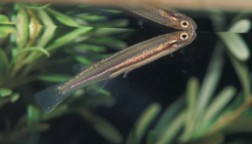
Trout Minnow
Photo: D. Morgan
FISH FACT: Australia's only CRITICALLY ENDANGERED freshwater fish, the Trout Minnow (Galaxias truttaceus) is one of our babies. We have been working on the species since 1996 when we first mapped its distribution in Two People's Bay and we drafted the nomination of the species to be recognised as endangered for the Federal anbd State governments. Our group drove the campaign to build a fishway on the Goodga River, which is WA's only vertical-slot fishway. We also discovered that for the Goodga River population, the larvae of the species spend their first few months as pelagic fish in Moates Lakes - some populations in eastern Australia have a marine larval stage! It is believed that all WA populations are land-locked and complete their life-cycle in freshwater.
Further reading:
Morgan, D.L. (2003). Distribution and biology of Galaxias truttaceus (Galaxiidae) in south-western Australia, including first evidence of parasitism of fishes in Western Australia by Ligula intestinalis. Environmental Biology of Fishes 66: 155-167.
Morgan, D.L. & Beatty, S.J. (2006). Use of a vertical-slot fishway by galaxiids in Western Australia. Ecology of Freshwater Fish 15: 500-509.
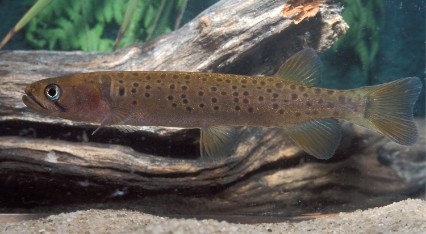
Common Jollytail
Photo: D. Morgan
FISH FACT: Otherwise known as the Spotted Minnow, we have adopted the common name the Common Jollytail so as to not get it confused with the Trout Minnow. This is why species names (i.e. Galaxias maculatus) are important in correctly identifying species. In this case, the number of common names are likely to be in the 100s, particularyly as it is one of the world's most widely distributed freshwater fish. It is found across southern Australia, east to New Zealand and South America, its wide geographical range put down to some populations having a marine larval stage. In south-western Australia however, our research has demonstrated that the species is ladlocked and complete their life-cycle in inland waters. Although some ocassional occurrences have turned up in the Swan, Harvey and Walpole rivers, the species is generally known from rivers east of the Goodga at Two People's Bay. In NZ the species forms an important fishery.
Further reading:
Chapman, A., Hobbs, R.P., Morgan, D.L. & Gill, H.S. (2006). Helminth parasitism of Galaxias maculatus (Jenyns, 1842) in south-western Australia. Ecology of Freshwater Fish 15: 559-564.
Chapman, A, Morgan, D.L., Beatty, S.J & Gill, H.S. (2006). Variation in life history of land-locked lacustrine and riverine populations of Galaxias maculatus (Jenyns 1842) in Western Australia. Environmental Biology of Fishes 77: 21-37.
Chapman, A., Morgan, D.L. & Gill, H.S. (2009). Description of the larval development of Galaxias maculatus in landlocked lentic and lotic systems in Western Australia. New Zealand Journal of Marine and Freshwater Research 43: 563-569.
Morgan, D.L. & Beatty, S.J. (2006). Use of a vertical-slot fishway by galaxiids in Western Australia. Ecology of Freshwater Fish 15: 500-509.
Morgan, D.L., Chapman, A., Beatty, S.J. & Gill, H.S. (2006). Distribution of the spotted minnow (Galaxias maculatus (Jenyns, 1842)) (Teleostei: Galaxiidae) in Western Australia including range extensions and sympatric species. Records of the Western Australian Museum 23: 7-11.
